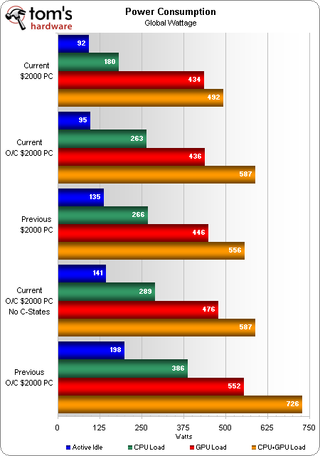System Builder Marathon, March 2011: $2000 Performance PC
Power, Heat, And Efficiency

Previous CPU-specific articles have already proven that Intel’s new processors are far less power-hungry than previous models, but some of that power savings will certainly be offset by the new build’s more power-hungry graphics cards.
The first part of the power chart that stands out is the new system’s idle power, which is barely affected by overclocking when C-States are enabled. The current overclocked system has similar load wattage to its non-overclocked predecessor.

Disabling C-States forced full-voltage and frequency to full-time status, costing around 46 W at idle and, surprisingly, 26 W at full CPU load. That’s really important this time, since appreciable performance benefits were limited to storage benchmarks.
Power consumption was so low on today’s overclocked build that we could easily have added a third graphics card, if only the power supply had the extra connectors for it. For those who would like to add a third card to this build, we recommend using at least one native PCIe power lead for each card and reserving the use of adapters for each card’s second power input. An 8-pin-to-dual-6-pin PCIe power splitter should supply enough current to supplement the second PCIe power input of two cards, while a dual-4-pin (drive)-to-single-6-pin (PCIe) adapter can supplement the third card’s second input.

Manual fan adjustment was required to overcome the poor thermal management of these cards when overclocked. Occasionally, the cards would even encounter a thermal lockup at stock frequency. A third-party fan controlling utility, such as the one built into MSI Afterburner, would have allowed a lower target temperature. But those who prefer not to use such utilities will find that AMD’s Catalyst fan control sufficient. A Catalyst fan setting of 40% explains the lower GPU temperature in the current build’s overclocked configuration.

The current build is 31% more efficient than the previous $2000 PC at stock speed, thanks to a 12% performance increase at 15% less power. Overclocking increased its performance by a greater amount than its power consumption, leading to improved efficiency at higher frequencies.
Hard drive, game, encoding, and productivity benchmarks each make up 25% of our performance average, while idle, CPU, GPU, and combined power each contributing 25% to our average power rating. Improved hard drive performance is primarily responsible for the current build’s 9% gain with C-States disabled, while lower idle power is the biggest contributor to its 2% efficiency gain with C-States enabled.
Stay on the Cutting Edge
Join the experts who read Tom's Hardware for the inside track on enthusiast PC tech news — and have for over 25 years. We'll send breaking news and in-depth reviews of CPUs, GPUs, AI, maker hardware and more straight to your inbox.
Current page: Power, Heat, And Efficiency
Prev Page Benchmark Results: Productivity Next Page Conclusion-
wribbs Was wondering when the SBM would return. Now if I just had an extra $2K. Now lets see how the lower price models hold up.Reply
Sure is a good time to be building a new PC. -
dragonsqrrl Wow, nice system this time around. Excellent performance and efficiency, although I personally would've chosen a nicer case for a $2000 system. I know you guys have your reasons, and for the purposes of a purely price/performance oriented build it makes sense to skimp on the aesthetic qualities of a case, but for me personally, it's still nice to see a high-end case complement some high-end hardware.Reply -
toxxel Nice system for 2k, wondering what the other systems will offer for their respective tier.Reply -
sparky2010 since the 6990 is out, wouldn't getting that one card be a legitimate choice too? isn't it also at around $600?Reply -
illuminatuz oh wow!!! you know what if you can really think you can make a performance pc.. i mean same performance.. but lesser cost..Reply
i am not saying OC and AMD thing.. same hardware.. -
dertechie That system looks familiar. Very familiar. Almost. . . have you been spying on me?Reply
I built a system exactly like that, except with an 2500K, P8P67 Pro, single 6950 2GB, single SSD, DVD rather than BD, H50 and a cheaper PSU. Tears through Metro 2033 maxed at 1920x1200 like butter. When prices on 6950s fall some more I'll add a card and see if they can handle Eyefinity. -
illuminatuz and its possible.. just take a nice gtx 560ti rather two amd sli and take 8 gig ram.. since anything above 8 gig will give diminishing returns and 500 gb hdd is more than enough i think.. buy a cheaper case, (punch holes to make it cooler :P) thats it.. same cpu same mobo and everything else same. you can also opt for cheaper 1155 mobo. i think gigabyte's got some.. or asus maybe.. no need for some two pcie and crap.. you can take a higher gpu.. say like gtx 580 or 6990.. well sli will give value if you are going for long term.. and you can install server's power.. they are cheap and of higher quality (thats what i heard from my pc vendor). i think there better be another marathon where there are the best pc at lowest cost.. that would make more sense rather giving budget.. so that people can know what they can make with the money they got.. since not all have exactly 1000$ or 2000$ there are people from other countries as well following www.tomshardware.com so keep up the good work fellas ^_^/~~Reply -
tapher Ten-ies!Reply
Props on the build, dawgs. Daddy likes!
Breath is bated for the bevy of builds to come!
Most Popular


